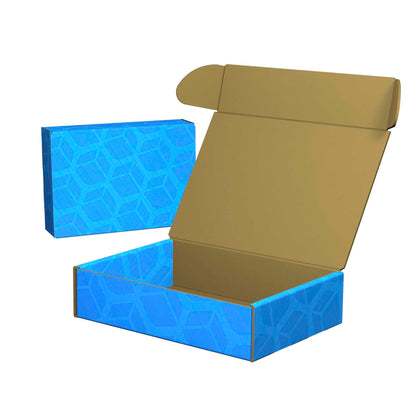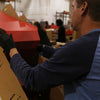

Creating custom health packaging doesn't have to be a difficult process, but sometimes it is. That's because you aren't sure where to start, what questions to ask, and the terms don't make any sense.
Perhaps you have packaging, but you're looking for ways to improve the design. There are several things you can do to make your custom health packaging stand out in a crowd.
Whatever your sales and marketing goals are this year, you need the right box to achieve them. The best packaging even creates brand loyalty – 52% of customers return for business if they like the packaging. It’s an easy thing for most brands to overlook, but this is exactly the issue we aim to solve.
We can help you update your brand from basic to premium by utilizing all of the most recent technological and marketing advancements to build fresh designs and, most importantly, increase your sales.
How custom Packaging helps your product
- Protect your products during shipping
- Tell your brand story and connect with your customer
- Include product benefits and valuable information
- Stand out to a consumer to increase their consideration
- Encourage customers to take a closer look
- Explain how to use your product
Table Of Contents
Two Levels Of Packaging
Before you begin producing your own health packaging, you must first get familiar with the many types of health packaging. For health and health items, there are often two types of packaging. There are two types of packaging: primary and secondary.
Primary Packaging
Primary health packaging contains all of the critical information about your product to assist you comprehend what's inside. On this side, you'll see ingredients and usage directions, as well as expiration dates, so users know when their item has to be replaced or returned for a refund if required (there may be some restrictions).
More information, such as storage suggestions, such as keeping items out of direct sunlight, and marketing visuals made expressly as eye candy, can be found on the other two sides.
Secondary Packaging
The company's logo and contact information are printed on the secondary health package. The finest examples are multi-product beauty kits or skincare subscription boxes, which include typical branding features such as a corporate logo, brand colors, company name and address, and other contact information.
Determine Your Packaging Needs
First, it's helpful to go through these questions to land on some specific decisions.
What type of Health Packaging do you need?
Depending on your goods, you'll require different types of packaging. This will be determined by the size, form, and weight of the individual.
If you have a delicate product, you'll want to think about a solution that's both structurally sound and cushioned.
Are there new innovations you can implement?
It's critical to get a leg up on the competition. You should do your homework or locate a reliable packaging partner that can keep you up to date on the newest market developments.
There are so many fresh and fascinating methods to reach customers, and you should integrate them in your new packaging design!
What type of product is it?
Each business has its own set of trends, and although you don't want to blend in, you do want your customers to recognize you as a part of that industry right away.
So either conduct some research on your competitors or contact a reputable packaging business for some advice.
What are your packaging dimensions?
Begin by measuring the height, breadth, and length of your goods, as well as the contents inside the box.
After that, think about the type and size of any protective packaging inserts you'll be using. The size of the box you'll need will be determined by this.
Pro Tip: Reduce the size of your package as much as feasible. This will ensure that the goods fits properly and that any shipping problems are avoided. Most significantly, you will save money and lessen your carbon footprint.
How many units do you need?
What do you intend to sell for? Do you require a total of 100 units? What is the number of people in your group? 500, 1,000, or 10,000? Will you require repeat orders?
This will have a direct impact on your costs, and the more you order, the better the bargain.
How can this be an extension of your brand?
This is a crucial aspect of the procedure. You want packaging that not only matches the contents of the package, but also complements your entire branding and marketing plan.
The colors you choose, the typefaces you use, the information and photos you provide - all of these things tell the buyer exactly "who you are," and they shouldn't be taken lightly.
Establish Your Packaging Budget
There are two types of costs associated with new packaging.
- Visible costs: such as the upfront cost of design and the price of the packaging itself.
- Hidden costs: such as additional filler, breakage, and more.
Your budget should include the cost of Packaging Supplies and Shipping Boxes. If any kind of packaging fillers are required, you need to account for them. You can also include a Contract Packager to help with fulfilment or assembly.
By using a company like Bennett, you get Turnkey Solutions that help you minimize costs.
A budget that addresses the economics of the entire process is required for a successful health packaging initiative. You should think about your product's pricing, profit margin, expected sales, and the length of time your packaging will be in place.
Setting a budget for your packaging, or at the very least a range, ensures that the procedure does not become inefficient or aimless.
Volume purchasing
Due to the economies of scale, like with most printed items, you only get a fair deal when you buy in bulk. If you don't buy in bulk, each package will add an unnecessarily high cost to each shipping.
If you do buy in bulk, you will not only be putting more money up front for production, but also for storage, transportation between warehouses and handling.
This is something that digital allows you to do with total freedom.
Choose A Printing Style
Choosing a printing solution entails more than just considering price. Technology has evolved throughout time, and although some previous approaches have proven to be beneficial, other technologies have provided whole new ways to assault the market.
Here are three printing options to consider:
Lithography Printing
Lithographic printing is the most common choice for commercial printing demands. It's also ideal if you're producing a single design that will be printed repeatedly without any tweaking.
The upfront fees for the printing plate, as well as the project's lead time, are two major difficulties.
If you go with Litho, you're committing to a period of waiting and a percentage of your budget before receiving your first box.
This is the way to go if you need a large volume manufacturing run of a single design.
High Speed Digital Printing
Bennett’s digital presses are game changing for the custom retail packaging industry.
While other firms may claim that Digital isn't competitive when it comes to huge orders, they fail to mention that Digital allows you to run a range of designs without having to pay for or wait for new printing plates.
In the business, digital has been developing, but only a few firms have begun to capitalize on this enormous opportunity.
Imagine being able to create regional messages, store-specific graphics, and seasonal or product variant sizes without incurring any additional expenditures.
We were the first company in North America to invest in a high-speed, single-pass, direct-to-corrugate, 6-color digital press.
Flexography Printing
Flexographic printing lowers printing costs, and tooling costs are usually cheaper as well. It has a quick turnaround time and can print with both water-based and oil-based inks.
Flexography, on the other hand, has a substantially worse printing quality than Lithography and Digital.
Smooth colors or gradients will have apparent banding, and it won't be able to make photo-quality photos.
Although the colors are not as brilliant or sharp as the other two alternatives, this printing format is less costly. It also doesn't need a great level of attention to detail and may be manufactured quickly.
Paper Coating
A coating can be applied to complete your packaging’s look – while offering additional protection and even enhancement.
Matte Lamination
While the overall effect of matte laminated surfaces is understated and elegant, it creates a noticeably high-end and sophisticated feel to your packaging.
Gloss Lamination
This provides a beautiful shine, vibrancy, better image contrast, and more vibrant depth of color. Gloss lamination even provides better protection against things like moisture and dust.
AQ Coating
is a clear, water-based coating that is capable of fast drying. It’s environmentally-friendly, making it a great choice for food, household, and fast-consuming products.
It has a very faint gloss finish compared to UV coating and lamination.
UV Coating
can create a similar look to lamination, but the difference is that UV is applied directly to the material. Packages are UV-coated using a flood or spot application.
Spot coating is applied to one area of the package, while flood (or overall) indicates a coating applied to the entire package. Spot UV is generally screen coated in thick amounts for maximum visual “pop” and rub-resistance.
While flood is usually roller coated in relatively smaller amounts.
Varnish
increases the perceived quality of the product. However, it offers a lower degree of protection in comparison to aqueous coating and UV coating.
They are also susceptible to yellowing over time. Varnishes are also not particularly eco-friendly. This is the least popular option.
Special Finishing
Consider enhancing your packaging by adding a more impactful look & feel. You can include a variety of special processes to create a more eye-catching design.
Foil Stamping
Perception is everything. A product with a foil-stamped package can have a higher perceived quality and value, than one in a standard package.
Foil also draws attention – which can make your product stand out among a crowd of competition.
Spot UV
Similar to UV coating, but this is applied to a specific area of the packaging, rather than coating the entire surface. This is to allow for these areas to be overprinted afterwards, as overprinting will not be successful on areas on which there is a UV varnish.
Embossing + Debossing
This will add dimension and depth to your packaging. Embossing and Debossing a printed sheet creates a raised (embossing) or lowered (debossing) area.
It is formed using male and female moulds or dies.
Window Cutting
Small windows can allow consumers to see the product inside, and can even allow the consumer to touch and use the product.
Toy packaging often uses windows to allow a consumer to press a button or interact with the toy.
Creating A Dieline
Now that you have your design in place, it’s time to transfer it to the structure template, a.k.a, the dieline.
There are a few dieline and artwork preparation and requirements that need to be noted by your designated designer, even if your artwork is done and ready to go.
If you do not have a designer, then your packaging company will take care of this for you.
Dielines
A dieline is typically created on a computer with a designing tool such as Adobe Illustrator, Artioscad, or Adobe InDesign. Measurements need to be precise, to save time and money.
Preparing The Artwork
You'll supply high-resolution artwork for printing in collaboration with your packaging partner. It's better if you chat directly with the firm you're dealing with to find out their particular CMYK printing specs.
Bennett offers award-winning Creative Services to assist you in designing, preparing, and delivering all of your artwork to our production teams – while ensuring that all of your project specifics are right along the way.
Pro Tip: Need more clarification on preparing your artwork? Reach out to Bennett if you need help with any of your designs!
Creating A Prototype Sample
If you have a large order, you should always request a prototype box to validate the construction and printing for final production. The prototype can be sent to you in person or through mail carrier after it is completed.
In our Creative Services Department, we offer a variety of equipment that will match the precise quality of our High-Speed Digital Printers, allowing you to acquire prototypes fast and take your idea forward to production.
Production + Shipping
Your retail package is ready to go into full production once you've finalized everything. You may sit back, relax, and wait for your packing to arrive!
Receiving your shipment all depends on your requested timeline, the size of the package, the method of delivery, etc.
Depending on your scenario, your account manager will keep you informed about the manufacturing and shipping processes, ensuring that you stay on schedule.
Learn more about Contract Packaging
Pro Tip: If you need to order on a consistent basis, speak to a packaging specialist to map out your inventory expectations and schedule. This will make it easier to maintain a healthy inventory flow and allow the manufacturer to know exactly when you need it.
Supply Chain Solutions
After you've finalized your Packaging design and are ready to begin manufacturing, you'll need to develop a Supply Chain strategy. You should think about the complete process, including manufacture, storage, and retailer distribution, among other things.
Key Questions:
- Will your Packaging be shipped fully assembled or KDF?
- What is the weight of your Packaging with your Shipping Box and Supplies?
- Where will you store your Packaging?
- What is the cost for Packaging Supplies?
- Fulfillment costs, if any?
- How will you account for returns?
Order Custom Health Packaging From Bennett Today!
Bennett is a leading packaging and retail display firm that uses bespoke corrugated solutions to preserve and showcase our clients' products. When you work for us, you become a member of the family. Every step of the journey, we'll be there with you.
With our fully-integrated design-to-delivery process, we can be the single supplier source. We are an award-winning manufacturer of virtually anything corrugate. We offer everything from plain brown shipping boxes to sophisticated, high-graphic printed point-of-purchase displays, and everything in between.




